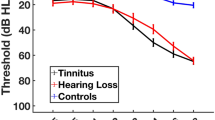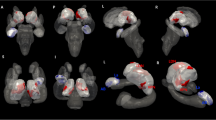Abstract
Aging and sensorineural hearing loss are known to be involved in the development of chronic tinnitus. This study explores the structural changes of gray matter using surface base methods and focuses more specifically on changes in cortical thickness in 127 tinnitus patients. The linear relationships between cortical thickness and behavioral measures including aging, tinnitus loudness, tinnitus duration, tinnitus distress, and hearing loss were analyzed. Three dimensional T1-weighted MR images were acquired and cortical gray matter volumes were segmented using FreeSurfer on Talairach space. The results showed that cortical thickness and volume are negatively correlated to age in widespread regions of frontal cortices, and positively to bilateral entorhinal cortex and left rostral anterior cingulate cortex. The cortical thickness changes related to hearing loss overlap with those related to normal aging. The gray matter volumes of bilateral amygdalae, hippocampi, nuclei accumbens, and thalami are all significantly negatively correlated to age. Tinnitus-related distress level and subjective loudness were negatively correlated only to the thalamic volume. The results suggest that the primary factor of long-term structural changes in chronic tinnitus patients is age and age related hearing loss, rather than hearing loss per se. Tinnitus related factors such as subjective tinnitus loudness, tinnitus duration, and the level of chronic tinnitus related distress were not correlated to important morphometric changes in this study.





Similar content being viewed by others
References
Abbena E, Salamon S, Gray A (2006) Modern differential geometry of curves and surfaces with Mathematica. CRC Press, Boca Raton
Aldhafeeri FM, Mackenzie I, Kay T, Alghamdi J, Sluming V (2012) Neuroanatomical correlates of tinnitus revealed by cortical thickness analysis and diffusion tensor imaging. Neuroradiology 54:883–892. doi:10.1007/s00234-012-1044-6
Allen JS, Bruss J, Brown CK, Damasio H (2005) Normal neuroanatomical variation due to age: the major lobes and a parcellation of the temporal region. Neurobiol Aging 26:1245–1260
Audiology BSO (2008) Recommended procedure: pure tone air and bone conduction threshold audiometry with and without masking and determination of uncomfortable loudness levels
Boyen K, Langers DR, de Kleine E, van Dijk P (2012) Gray matter in the brain: differences associated with tinnitus and hearing loss. Hear Res. doi:10.1016/j.heares.2012.02.010
Boyen K, Langers DR, de Kleine E, van Dijk P (2013) Gray matter in the brain: differences associated with tinnitus and hearing loss. Hear Res 295:67–78
Brozoski T, Odintsov B, Bauer C (2012) Gamma-aminobutyric acid and glutamic acid levels in the auditory pathway of rats with chronic tinnitus: a direct determination using high resolution point-resolved proton magnetic resonance spectroscopy (H-MRS). Front Syst Neurosci 6:9. doi:10.3389/fnsys.2012.00009
Chao L, Knight R (1997) Prefrontal deficits in attention and inhibitory control with aging. Cereb Cortex 7:63–69
Chung DY, Gannon RP, Mason K (1984) Factors affecting the prevalence of tinnitus. Audiology 23:441–452
Collins DL, Neelin P, Peters TM, Evans AC (1994) Automatic 3D intersubject registration of MR volumetric data in standardized Talairach space. J Comput Assist Tomogr 18:192–205
Crippa A, Lanting CP, van Dijk P, Roerdink JB (2010) A diffusion tensor imaging study on the auditory system and tinnitus. Open Neuroimaging J 4:16–25. doi:10.2174/1874440001004010016
Dale AM, Fischl B, Sereno MI (1999) Cortical surface-based analysis: I. Segmentation and surface reconstruction. Neuroimage 9:179–194
De Ridder D, Fransen H, Francois O, Sunaert S, Kovacs S, Van De Heyning P (2006) Amygdalohippocampal involvement in tinnitus and auditory memory. Acta Otolaryngol 126:50–53
De Ridder D, Vanneste S, Congedo M (2011) The distressed brain: a group blind source separation analysis on tinnitus. PLoS One 6:e24273. doi:10.1371/journal.pone.0024273
Eggermont JJ, Roberts LE (2004) The neuroscience of tinnitus. Trends Neurosci 27:676–682
Elgoyhen AB, Langguth B, De Ridder D, Vanneste S (2015) Tinnitus: perspectives from human neuroimaging. Nat Rev Neurosci 16:632–642. doi:10.1038/nrn4003
Fischl B, Dale AM (2000) Measuring the thickness of the human cerebral cortex from magnetic resonance images. Proc Natl Acad Sci 97:11050–11055
Fischl B, Sereno MI, Dale AM (1999) Cortical surface-based analysis: II: inflation, flattening, and a surface-based coordinate system. Neuroimage 9:195–207
Fischl B et al (2002) Whole brain segmentation: automated labeling of neuroanatomical structures in the human brain. Neuron 33:341–355
Fjell AM et al (2009) One-year brain atrophy evident in healthy aging. J Neurosci 29:15223–15231
Fjell AM, McEvoy L, Holland D, Dale AM, Walhovd KB, AsDN Initiative (2014) What is normal in normal aging? Effects of aging, amyloid and Alzheimer’s disease on the cerebral cortex and the hippocampus. Prog Neurobiol 117:20–40
Gates GA, Mills JH (2005) Presbycusis. The Lancet 366:1111–1120
Gilles A, De Ridder D, Van Hal G, Wouters K, Kleine Punte A, Van de Heyning P (2012) Prevalence of leisure noise-induced tinnitus and the attitude toward noise in university students. Otol Neurotol 33:899–906. doi:10.1097/MAO.0b013e31825d640a
Hagler DJ, Saygin AP, Sereno MI (2006) Smoothing and cluster thresholding for cortical surface-based group analysis of fMRI data. Neuroimage 33:1093–1103
Helfer TM (2011) Noise-induced hearing injuries, active component, U.S. Armed Forces, 2007–2010. MSMR 18:7–10
Hiller W, Goebel G (1992) A psychometric study of complaints in chronic tinnitus. J Psychosom Res 36:337–348
Hiller W, Goebel G, Rief W (1994) Reliability of self-rated tinnitus distress and association with psychological symptom patterns. Br J Clin Psychol 33(Pt 2):231–239
Huang Q, Tang J (2010) Age-related hearing loss or presbycusis. Eur Arch Otorhinolaryngol 267:1179–1191
Husain FT, Medina RE, Davis CW, Szymko-Bennett Y, Simonyan K, Pajor NM, Horwitz B (2011) Neuroanatomical changes due to hearing loss and chronic tinnitus: a combined VBM and DTI study. Brain Res 1369:74–88. doi:10.1016/j.brainres.2010.10.095
Hutton C, Draganski B, Ashburner J, Weiskopf N (2009) A comparison between voxel-based cortical thickness and voxel-based morphometry in normal aging. Neuroimage 48:371–380
Kaltenbach JA, Afman CE (2000) Hyperactivity in the dorsal cochlear nucleus after intense sound exposure and its resemblance to tone-evoked activity: a physiological model for tinnitus. Hear Res 140:165–172
Kreuzer PM, Landgrebe M, Vielsmeier V, Kleinjung T, De Ridder D, Langguth B (2014) Trauma-associated tinnitus. J Head Trauma Rehabil 29:432–442. doi:10.1097/HTR.0b013e31829d3129
Landgrebe M et al (2009) Structural brain changes in tinnitus: grey matter decrease in auditory and non-auditory brain areas. Neuroimage 46:213–218. doi:10.1016/j.neuroimage.2009.01.069
Langguth B, Kreuzer PM, Kleinjung T, De Ridder D (2013) Tinnitus: causes and clinical management. Lancet Neurol 12:920–930. doi:10.1016/S1474-4422(13)70160-1
Leaver AM, Renier L, Chevillet MA, Morgan S, Kim HJ, Rauschecker JP (2011) Dysregulation of limbic and auditory networks in tinnitus. Neuron 69:33–43. doi:10.1016/j.neuron.2010.12.002
Lin FR, Ferrucci L, Metter EJ, An Y, Zonderman AB, Resnick SM (2011) Hearing loss and cognition in the Baltimore Longitudinal Study of Aging. Neuropsychology 25:763
MacDonald D, Kabani N, Avis D, Evans AC (2000) Automated 3-D extraction of inner and outer surfaces of cerebral cortex from MRI. NeuroImage 12:340–356
Mahoney CJ, Rohrer JD, Goll JC, Fox NC, Rossor MN, Warren JD (2011) Structural neuroanatomy of tinnitus and hyperacusis in semantic dementia. J Neurol Neurosurg Psychiatry 82:1274–1278. doi:10.1136/jnnp.2010.235473
McCombe A, Baguley D, Coles R, McKenna L, McKinney C, Windle-Taylor P (2001) Guidelines for the grading of tinnitus severity: the results of a working group commissioned by the British Association of Otolaryngologists, Head and Neck Surgeons, 1999. Clin Otolaryngol Allied Sci 26:388–393
Meeus O, Blaivie C, Van de Heyning P (2007) Validation of the Dutch and the French version of the Tinnitus Questionnaire. B-Ent 3(Suppl 7):11–17
Meeus O, Heyndrickx K, Lambrechts P, De Ridder D, Van de Heyning P (2009) Phase-shift treatment for tinnitus of cochlear origin. Eur Arch Otorhinolaryngol. doi:10.1007/s00405-009-1145-y
Meeus O, De Ridder D, Van de Heyning P (2011) Administration of the combination clonazepam-Deanxit as treatment for tinnitus. Otol Neurotol. doi:10.1097/MAO.0b013e31820e737c
Melcher JR, Knudson IM, Levine RA (2012) Subcallosal brain structure: correlation with hearing threshold at supra-clinical frequencies (>8 kHz), but not with tinnitus. Hear Res 295:79–86. doi:10.1016/j.heares.2012.03.013
Mirz F, Gjedde A, Ishizu K, Pedersen CB (2000a) Cortical networks subserving the perception of tinnitus–a PET study. Acta Otolaryngol Suppl 543:241–243
Mirz F, Gjedde A, Sdkilde-Jrgensen H, Pedersen CB (2000b) Functional brain imaging of tinnitus-like perception induced by aversive auditory stimuli. NeuroReport 11:633–637
Mühlau M et al (2006) Structural brain changes in tinnitus. Cereb Cortex 16:1283–1288
Muhr P, Rosenhall U (2010) Self-assessed auditory symptoms, noise exposure, and measured auditory function among healthy young Swedish men. Int J Audiol 49:317–325. doi:10.3109/14992020903431280
Nondahl DM, Cruickshanks KJ, Huang G-H, Klein BE, Klein R, Tweed TS, Zhan W (2012) Generational differences in the reporting of tinnitus. Ear Hear 33:640
Pakkenberg B, Gundersen HJG (1997) Neocortical neuron number in humans: effect of sex and age. J Comp Neurol 384:312–320
Pardo JV et al (2007) Where the brain grows old: decline in anterior cingulate and medial prefrontal function with normal aging. Neuroimage 35:1231–1237
Pereira JB, Ibarretxe-Bilbao N, Marti MJ, Compta Y, Junqué C, Bargallo N, Tolosa E (2012) Assessment of cortical degeneration in patients with Parkinson’s disease by voxel-based morphometry, cortical folding, and cortical thickness. Hum Brain Mapp 33:2521–2534
Pilgramm M, Rychlick R, Lebisch H, Siedentop H, Goebel G, Kirchhoff D (1999) Tinnitus in the Federal Republic of Germany: a representative epidemiological study. In: Proceedings of the sixth international tinnitus seminar, 1999. The Tinnitus and Hyperacusis Society Cambridge, United Kingdom, pp 64–67
Salat DH et al (2004) Thinning of the cerebral cortex in aging. Cereb Cortex 14:721–730
Salvi RJ, Wang J, Ding D (2000) Auditory plasticity and hyperactivity following cochlear damage. Hear Res 147:261–274
Schecklmann M et al (2013) Auditory cortex is implicated in tinnitus distress: a voxel-based morphometry study. Brain Struct Funct 218:1061–1070. doi:10.1007/s00429-013-0520-z
Schlee W, Mueller N, Hartmann T, Keil J, Lorenz I, Weisz N (2009) Mapping cortical hubs in tinnitus. BMC Biol 7:80. doi:10.1186/1741-7007-7-80
Shargorodsky J, Curhan GC, Farwell WR (2010) Prevalence and characteristics of tinnitus among US adults. Am J Med 123:711–718. doi:10.1016/j.amjmed.2010.02.015
Smits M, Kovacs S, de Ridder D, Peeters RR, van Hecke P, Sunaert S (2007) Lateralization of functional magnetic resonance imaging (fMRI) activation in the auditory pathway of patients with lateralized tinnitus. Neuroradiology 49:669–679. doi:10.1007/s00234-007-0231-3
Sobel ME (1987) Direct and indirect effects in linear structural equation models. Sociol Methods Res 16:155–176
Tisserand DJ, Pruessner JC, Arigita EJS, van Boxtel MP, Evans AC, Jolles J, Uylings HB (2002) Regional frontal cortical volumes decrease differentially in aging: an MRI study to compare volumetric approaches and voxel-based morphometry. Neuroimage 17:657–669
van der Loo E, Congedo M, Vanneste S, De Heyning PV, De Ridder D (2011) Insular lateralization in tinnitus distress. Auton Neurosci 165:191–194. doi:10.1016/j.autneu.2011.06.007
Van Essen DC (2005) A population-average, landmark-and surface-based (PALS) atlas of human cerebral cortex. Neuroimage 28:635–662
Van Essen DC, Drury HA, Dickson J, Harwell J, Hanlon D, Anderson CH (2001) An integrated software suite for surface-based analyses of cerebral cortex. J Am Med Inf Assoc 8:443–459
Vanneste S, Plazier M, der Loo E, de Heyning PV, Congedo M, De Ridder D (2010) The neural correlates of tinnitus-related distress. Neuroimage 52:470–480. doi:10.1016/j.neuroimage.2010.04.029
Vanneste S, de Heyning PV, Ridder DD (2011) Contralateral parahippocampal gamma-band activity determines noise-like tinnitus laterality: a region of interest analysis. Neuroscience 199:481–490
Vanneste S, Van De Heyning P, De Ridder D (2015) Tinnitus: a large VBM-EEG correlational study. PLoS One 10:e0115122. doi:10.1371/journal.pone.0115122
Winkler AM et al (2010) Cortical thickness or grey matter volume? The importance of selecting the phenotype for imaging genetics studies. NeuroImage 53:1135–1146. doi:10.1016/j.neuroimage.2009.12.028
Winkler AM et al (2012) Measuring and comparing brain cortical surface area and other areal quantities. Neuroimage 61:1428–1443
Yoo HB, De Ridder D, Vanneste S (2015) White matter changes in tinnitus: is it all age and hearing loss? Brain connectivity 6(1):84–93
Author information
Authors and Affiliations
Corresponding author
Rights and permissions
About this article
Cite this article
Yoo, H.B., De Ridder, D. & Vanneste, S. The Importance of Aging in Gray Matter Changes Within Tinnitus Patients Shown in Cortical Thickness, Surface Area and Volume. Brain Topogr 29, 885–896 (2016). https://doi.org/10.1007/s10548-016-0511-5
Received:
Accepted:
Published:
Issue Date:
DOI: https://doi.org/10.1007/s10548-016-0511-5




